*NURSING > STUDY GUIDE > NURS 6531N FINAL QUESTIONS AND ANSWERS/ ALREADY GRADED A (All)
NURS 6531N FINAL QUESTIONS AND ANSWERS/ ALREADY GRADED A
Document Content and Description Below
NURS 6531N FINAL QUESTIONS AND ANSWERS • Question 1 0 out of 0 points When completing this quiz, did you comply with Walden University’s Code of Conduct including the expectations for aca... demic integrity? • Question 2 1 out of 1 points A patient complains of generalized joint pain and stiffness associated with activity and relieved with rest. This patient history is consistent with which of the following disorders? Osteoarthritis • Question 3 0 out of 1 points What diabetic complications result from hyperglycemia? 1. 1. 1. Retinopathy 2. Hypertension resistant to treatment 3. Peripheral neuropathy 4. Accelerated atherogenesis 5. • Question 4 0 out of 1 points Which factors are associated with high risk for foot complications in a patient with diabetes mellitus? 1. Obesity 2. Abnormal nails 3. Abnormal gait 4. Poorly controlled lipids 5. • Question 5 1 out of 1 points Which of the following is not a common early sign of benign prostatic hyperplasia (BPH)? What are common early signs of BPH – frequency, urgency, nocturia TX with alpha adrenergic Terazosin and doxazosin • Question 6 1 out of 1 points A 63-year-old man presents to the office with hematuria, hesitancy, and dribbling. Digital rectal exam (DRE) reveals a moderately enlarged prostate that is smooth. The PSA is 1.2. What is the most appropriate management strategy for you to follow at this time? Prescribe an alpha adrenergic blocker • Question 7 0 out of 1 points A 30 year old female patient presents to the clinic with heat intolerance, tremors, nervousness, and weight loss inconsistent with increased appetite. Which test would be most likely to confirm the suspected diagnosis? Graves hyperthyroid • Question 8 1 out of 1 points Which history is commonly found in a patient with glomerulonephritis? Ask about recent infections (skin or upper respiratory); recent travel (possible exposure to viruses, bacteria, fungi, or parasites); recent illnesses, surgery, or invasive procedures (possible infection); any systemic diseases (Systemic Lupus Erythematosus -SLE) • Question 9 1 out of 1 points A 60 year old male patient with multiple health problems presents with a complaint of erectile dysfunction (ED). Of the following, which medication is most likely to be causing the problem? diabetes • Question 10 0 out of 1 points Which of the following is not a characteristic of type 2 diabetes mellitus? characterized by high blood sugar, insulin resistance, and relative lack of insulin. Common symptoms include increased thirst, frequent urination, and unexplained weight loss. • Question 11 1 out of 1 points A patient has been diagnosed with hypothyroidism and thyroid hormone replacement therapy is prescribed. How long should the nurse practitioner wait before checking the patient’s TSH? Six to 8 weeks • Question 12 0 out of 1 points A patient has been diagnosed with generalized anxiety disorder (GAD). Which of the following medications may be used to treat generalized anxiety disorder? Treatment may include counseling and medications, such as antidepressants. Selective Serotonin Reuptake Inhibitor (SSRI), Anxiolytic, and Antidepressant Paxil Effexor Lexapro and cymbalta • Question 13 0 out of 1 points What is the most common cause of Cushing’s syndrome? Pituitary-dependent/ACTH-dependent (Cushing's disease), one is a pituitary form, which results from excessive production of ACTH by a tumor of the pituitary gland, • Question 14 1 out of 1 points Which of the following is the most cause of low back pain? Lumbar disc disease • Question 15 1 out of 1 points Warfarin (Coumadin) is prescribed for a frail, elderly male with new onset atrial fibrillation. The goal INR for this patient should be: 2.0 to 3.0 • Question 16 1 out of 1 points A 72 year old patient exhibits sudden onset of fluctuating restlessness, agitation, confusion, and impaired attention. This is accompanied by visual hallucinations and sleep disturbance. What is the most likely cause of this behavior? delirium • Question 17 1 out of 1 points Which of the following is the most common causative organism of nongonococcal urethritis? which of the following does not cause nongonococcal urethritis a chlamydia – most common b. mycoplasma c. neisseria d. ureaplasma • Question 18 1 out of 1 points Which appropriate test for the initial assessment of Alzheimer’s disease provides the performance ratings on 10 complex, higher order activities? FAQ • Question 19 0 out of 1 points What conditions must be met for you to bill “incident to” the physician, receiving 100% reimbursement from Medicare? the physician must be on-site and engaged in client care. • Question 20 1 out of 1 points Diagnostic evaluation for urinary calculi includes: A. Urinalysis and culture B. Non contrast CT C. Serum calcium D. All of the above • Question 21 1 out of 1 points Reed-Sternberg B lymphocytes are associated with which of the following disorders: Hodgkin’s lymphoma • Question 22 0 out of 1 points Marsha presents with symptoms resembling both fibromyalgia and chronic fatigue syndrome, which have many similarities. Which of the following is more characteristic of fibromyalgia? Musculoskeletal pain is not characteristic of chronic fatigue syndrome; rather, it is characteristic of fibromyalgia • Question 23 1 out of 1 points Beth, age 49, comes in with low back pain. An x-ray of the lumbosacral spine is within normal limits. Which of the following diagnoses do you explore further? herniated nucleus pulposus. • Question 24 0 out of 1 points Steve, age 69, has gastroesophageal reflux disease (GERD). When teaching him how to reduce his lower esophageal sphincter pressure, which substances do you recommend that he avoid? avoid chocolate, alcohol, carbonated drinks, peppermint, coffee, citrus, onion, and garlic. And weight loss • Question 25 1 out of 1 points The cornerstone of treatment for stress fracture of the femur or metatarsal stress fracture is: Rest the affected part of the body - Once pain free, the person can gradually begin the sporting activity again - Air splinting can reduce pain and decrease the time until return to full participation or intensity of exercise. - NSAIDs to reduce pain and inflammation • Question 26 0 out of 1 points Which of the following is not a risk factor associated with the development of syndrome X and type 2 diabetes mellitus? Post-prandial hypoglycemia • Question 27 1 out of 1 points A thymectomy is usually recommended in the early treatment of which disease? Thymectomy is an important treatment option for Myasthenia Gravis • Question 28 0 out of 1 points The most common cause of elevated liver function tests is: Chronic alcohol abuse. • Question 29 1 out of 1 points A 14 year old female cheerleader reports gradual and progressive dull anterior knee pain, exacerbated by kneeling. The nurse practitioner notes swelling and point tenderness at the tibial tuberosity. X-ray is negative. What is the most likely diagnosis? Osgood The most likely diagnosis based on the reports of gradual progressive dull anterior knee pain cause of kneeling and the complains of sore lump on the patient’s knee which the result of the assessment notes were swelling and point tenderness is likely Arthritis or gout. It is the symptoms of Arthritis or gouts usually complaining having knee pain and swelling. • Question 30 1 out of 1 points Which of the following is a contraindication for metformin therapy? Creatinine > 1.5 • Renal dysfunction. • Congestive cardiac failure needing drug treatment. • Hypersensitivity to metformin. • Acute or chronic metabolic acidosis. • Impaired hepatic function. • Question 31 0 out of 1 points The best test to determine microalbuminuria to assist in the diagnosis of diabetic neuropathy: albumin-to-creatinine ratio with a spot urine • Question 32 1 out of 1 points Which is the most common cause of end-stage renal disease in the United States? Diabetic Neuropahty, hypertenson, glomerulonephritis, systemic lupus, cystic kidney disease • Question 33 0 out of 1 points A middle-aged female presents complaining of recent weight loss. The physical exam reveals an enlarged painless cervical lymph node. The differential diagnosis for this patient’s problem includes: All of the above (mono, toxoplasmosis, and infection) • Question 34 1 out of 1 points Risk factors for prostate cancer include all of the following except: History of genital trauma and bph • Question 35 1 out of 1 points Phalen’s test, 90°wrist flexion for 60 seconds, reproduces symptoms of: carpal tunnels • Question 36 1 out of 1 points The most effective intervention(s) to prevent stroke is (are): smoking cessation and treatment of hypertension • Question 37 1 out of 1 points A diabetic patient is taking low-dose enalapril for hypertension. A record of the patient’s blood pressure over 4 weeks ranges from 130 to 142 mmHg systolic and 75 to 85 mmHg diastolic. How should the nurse practitioner respond? increase the dosage of the current BP medication • Question 38 0 out of 1 points Microalbuminuria is a measure of: endothelial dysfunction, dm neuropathy, diabetic kidney disease and end organ damage r/t htn • Question 39 0 out of 1 points Martin, age 24, presents with an erythematous ear canal, pain, and a recent history of swimming. What do you suspect? External otitis • Question 40 1 out of 1 points A 32 year old male patient complains of urinary frequency and burning on urination for 3 days. Urinalysis reveals bacteriuria. He denies any past history of urinary tract infection. The initial treatment should be: : cipro or Levaquin fluoroquinolones 10 to 14 days trimethoprim sulfamethoxazole for 14 days UTI in males should be treated with fluoroquinolones for 10 to 14 days. Acute bacterial prostatitis requires 2 weeks of oral antibiotic treatment with trimethoprim-sulfamethoxazole (TMP-SMX) or fluoroquinolones. Chronic bacterial prostatitis may require 4 to 6 weeks of treatment. • Question 41 0 out of 1 points A 21-year-old female presents to the office complaining of urinary frequency and urinary burning. The nurse practitioner suspects a urinary tract infection when the urinalysis reveals 10 WBC/ HP Pyuria (neutrophils in the urine) Bacteriuria Hematuria Positive leukocyte esterase and/or nitrite dipstick (Leukocyte esterase = indicates presence of WBCs; suggests bacterial cause) (Positive nitrite = indicates gram - organism) Urine culture indicated in symtpoms and negative urinalysis • Question 42 1 out of 1 points Which of the following medications increase the risk for metabolic syndrome? Antihistamine and protease inhibitor • Question 43 1 out of 1 points The most accurate measure of diabetes control is: a1c • Question 44 0 out of 1 points The 4 classic features of Parkinson’s disease are: shaking (tremor) of the hands, arms, legs and face; stiffness; slow movement (bradykinesia); and difficulty with balance and coordination. • Question 45 0 out of 1 points A child with type 1 diabetes mellitus has experienced excessive hunger, weight gain and increasing hyperglycemia. The Somogyi effect is suspected. What steps should be taken to diagnose and treat this condition? Testing blood sugar levels at 3.00 a.m. and again in the morning can help distinguish between the Somogyi effect and the dawn phenomenon. ’s relatively easy to test for the Somogyi effect. For several consecutive nights: • Check your blood sugar just before bed. • Set an alarm to check it again around 3:00 a.m. • Test it again upon waking. If your blood glucose is low when you check it at 3:00 a.m., it’s likely the Somogyi effect. • Question 46 1 out of 1 points A patient presents with dehydration, hypotension, and fever. Laboratory testing reveals hyponatremia, hyperkalemia, and hypoglycemia. These imbalances are corrected, but the patient returns 6 weeks later with the same symptoms of hyperpigmentation, weakness, anorexia, fatigue, and weight loss. What action(s) should the nurse practitioner take? the correct next step is to measure baseline serum cortisol, to test ACTH levels, and to order an ACTH stimulation test with cosyntropin.Primary adrenocortical insufficiency work up for • Question 47 0 out of 1 points Other than smoking cessation, which of the following slows the progression of COPD in smokers? Engaging in moderate-to-high levels of physical activity • Question 48 1 out of 1 points A 75-year-old female is diagnosed with primary hyperparathyroidism and asks the nurse practitioner what the treatment for this disorder is. The nurse practitioner explains: Primary hyperparathyroidism is treated with parathyroidectomy • Question 49 0 out of 1 points The hallmark of neurofibromatosis (von Recklinghausen’s disease) present in almost 100% of patients is: Café au lait spots • Question 50 0 out of 1 points A patient has HIV infection and is having a problem with massive diarrhea. You suspect the cause is: . Cryptosporidiosis - When patients with HIV infection have massive diarrhea, a protozoa of the cryptosporidium genus is the most likely cause. • Question 51 0 out of 1 points How do you respond when Jessica, age 42, asks you what constitutes a good minimum cardiovascular workout? Exercising for at least 20 minutes 3 or more days per week. • Question 52 1 out of 1 points The treatment of choice for chronic bacterial prostatitis (CBP) is: Fluoroquinolones (Ciprofloxacin, levofloxacin, others)- antibiotics of choice Trimethoprim-sulfamethoxazole - less effective but still an option Other antibiotics - doxycycline, cephalexin, erythromycin Treat for 4 weeks minimum • Question 53 0 out of 1 points Sally, a computer programmer, has just been given a new diagnosis of carpal tunnel syndrome. Your next step is to: try neutral position wrist splinting and order an oral NSAID • Question 54 0 out of 1 points Urine cultures should be obtained for which of the following patients? All of the above (pregnant females, males, and febrile patients) • Question 55 1 out of 1 points Which of the following is the best response to a woman who has just admitted she is a victim of spousal abuse? • Question 56 0 out of 1 points The diagnosis which must be considered in a patient who presents with a severe headache of sudden onset, with neck stiffness and fever, is: migrane or meningitis • Question 57 0 out of 1 points An 81-year-old female is diagnosed with type 2 diabetes. When considering drug therapy for this patient, the nurse practitioner is most concerned with which of the following side effects? hypogyclemia • Question 58 0 out of 1 points Which patient would benefit most from screening for type 2 diabetes? Gdma, black, htn, pcos, black, family hx • Question 59 0 out of 1 points The intervention known to be most effective in the treatment of severe depression, with or without psychosis, is: electroconvulsive therapy (ECT). • Question 60 0 out of 1 points Jennifer says that she has heard that caffeine can cause osteoporosis and asks you why. How do you respond? The effect of caffeine in causing osteoporosis is controversial, but it is postulated to result from caffeine ' s diuretic effect that causes calcium to be excreted more rapidly • Question 61 0 out of 1 points Which of the following patients most warrants screening for hypothyroidism? Screening whole populations for hypothyroidism is not warranted. There is a high prevalence of hypothyroidism among the elderly with cognitive impairment. • Question 62 0 out of 1 points Successful management of a patient with attention deficit hyperactivity disorder (ADHD) may be achieved with: psychostimulant Ritalin ii. Dexedrine iii. Focalin iv. Adderall v. Concerta vi. Strattera • Question 63 0 out of 1 points Diabetes screening recommendations for asymptomatic adults age 45 and over include which of the following: A. HbA1C B. 2-hour 75 gram oral glucose tolerance test C. C-peptide level D. A and B E. All of the above • Question 64 0 out of 1 points Prolonged PT suggests: Liver disease, DIC (early)Warfarin, Factor VII deficiency • Question 65 0 out of 1 points Diagnostic confirmation of acute leukemia is based on: Bone marrow aspiration and biopsy • Question 66 0 out of 1 points Which of the following is not appropriate suppression therapy for chronic bacterial prostatitis? • Question 67 0 out of 1 points The most effective treatment of non-infectious bursitis includes: Need options rest, cold and heat treatments, elevation, administration of nonsteroidal anti-inflammatory drugs (NSAIDs), bursal aspiration, and intrabursal steroid injections (with or without local anesthetic agents). • Question 68 0 out of 1 points Differential diagnosis of proteinuria includes which of the following? Differential diagnosis of proteinuria includes which of the following? A. Orthostatic proteinuria B. Nephrotic syndrome C. Infection D. Trauma E. A and B • Question 69 0 out of 1 points You are assessing a patient after a sports injury to his right knee. You elicit a positive anterior/posterior drawer sign. This test indicates an injury to the: cruciatanklee ligament • Question 70 0 out of 1 points A positive drawer sign supports a diagnosis of: cruciate ligament • Question 71 0 out of 1 points A patient presenting for an annual physical exam has a BMI of 25 kg/m2 This patient would be classified as: overweight • Question 72 0 out of 1 points A patient has been taking fluoxetine (Prozac) since being diagnosed with major depression, first episode, 2 months ago. She reports considerable improvement in her symptoms and her intention to discontinue the medication. What should be the nurse practitioner’s recommendation? Recommend that the patient continue the antidepressant medication for at least 4 more months. • Question 73 0 out of 1 points Diagnostic radiological studies are indicated for low back pain: Xray • Question 74 0 out of 1 points A 32 year old female patient presents with fever, chills, right flank pain, right costovertebral angle tenderness, and hematuria. Her urinalysis is positive for leukocytes and red blood cells. The nurse practitioner diagnoses pyelonephritis. The most appropriate management is: Cipro if symptoms does not go away within 2 days hospitalization • Question 75 0 out of 1 points Which of the following symptoms suggests a more serious cause of back pain? Pain with lying • Question 76 0 out of 1 points What is the first step in the treatment of uric acid kidney stones? Encouraging hydration • Question 77 0 out of 1 points A 20 year old male patient complains of “scrotal swelling.” He states his scrotum feels heavy, but denies pain. On examination, the nurse practitioner notes transillumination of the scrotum. What is the most likely diagnosis? Nonseminoma • Question 78 0 out of 1 points What is the first symptom seen in the majority of patients with Parkinson’s disease? Resting tremor • Question 79 0 out of 1 points A 60 year old female patient complains of sudden onset unilateral, stabbing, surface pain in the lower part of her face lasting a few minutes, subsiding, and then returning. The pain is triggered by touch or temperature extremes. Physical examination is normal. Which of the following is the most likely diagnosis? Trigeminal neuralgia • Question 80 0 out of 1 points Which of the following set of symptoms should raise suspicion of a brain tumor? Holocranial headaches present in the morning and accompanied by projectile vomiting without nausea • Question 81 0 out of 1 points The most reliable indicator(s) of neurological deficit when assessing a patient with acute low back pain is(are): straight leg raise test is performed to assess for damage to L5-S1 • Question 82 0 out of 1 points A 25 year old overweight patient presents with a complaint of dull achiness in his groin and history of a palpable lump in his scrotum that “comes and goes”. On physical examination, the nurse practitioner does not detect a scrotal mass. There is no tenderness, edema, or erythema of the scrotum, the scrotum does not transilluminate. What is the most likely diagnosis? Inguinal hernia • Question 83 0 out of 1 points Which of the following characteristics are associated with prepatellar bursitis? Repetitive knee trauma • Question 84 0 out of 1 points Which drug category contains the drugs that are the first line Gold standard therapy for COPD? anticholenergic • Question 85 0 out of 1 points Which of the following physical modalities recommended for treatment of rheumatoid arthritis provides the most effective long term pain relief? Physiotherapy • Question 86 0 out of 1 points Which of the following accounts for half of the bladder tumors among men and one-third in women? Cigarette smoke, both active and passive inhalation Cigarette smoke, both active and passive inhalation • Question 87 0 out of 1 points A 35 year old male presents with a complaint of low pelvic pain, dysuria, hesitancy, urgency, and reduced force of stream. The nurse practitioner suspects acute bacterial prostatitis. Which of the following specimens would be least helpful for diagnosis? Post void Ordered test – that are helpful Midstream urine specimens for culture and sensitivity CBC and differential Blood urea nitrogen Creatinine Imaging • Question 88 0 out of 1 points In which of the following presentations is further diagnostic testing not warranted? Bilateral gynecomastia in a pre-pubertal • Question 89 0 out of 1 points Martin is complaining of erectile dysfunction. He also has a condition that has reduced arterial blood flow to his penis. The most common cause of this condition is: htn dm • Question 90 0 out of 1 points Which of the following is the most common complication of the myelodysplastic syndromes? Fatigue • Question 91 0 out of 1 points You have a new patient that presents with generalized lymphadenopathy. You know that this is indicative of: A. Infection B. Malignancy C. Inflammation D. Drug E. Endocrine B. A. Infection - Viral: infectious mononucleosis (CMV, EBP), HIV - Bacterial: skin infection, TB - Fungal: cryptococcal B. Malignancy - Hematological: lymphoma, leukemia - Solid tumour LN met C. Inflammatory - Castleman ds - Kimura ds - Kikuchi ds - SLE, RA - Amyloidosis, sarcoidosis D. Drug - Phenytoin (anti-seizure) - Hydralazine (HF) E. Endocrine [rare] - Addison's disease - Hypothyroidism • Question 92 0 out of 1 points A 15 year-old female patient is 5 feet tall and weighs 85 pounds. You suspect anorexia and know that the best initial approach is to: confront Julie with the fact that you suspect an eating disorder • Question 93 0 out of 1 points A patient taking levothyroxine is being over-replaced. What condition is he at risk for? Osteoporosis, arrhythmias, afib • Question 94 0 out of 1 points A nurse practitioner diagnoses a 60 year old male with balanitis. Which disease is commonly associated with balanitis? diabetes • Question 95 0 out of 1 points The diagnosis of human papilloma virus (HPV) infection in males is usually made by: warts • Question 96 0 out of 1 points Martin, a 58 year old male with diabetes, is at your office for his PRO follow up. On examining his feet with monofilament, you discover that he has developed decreased sensation in both feet. There are no open areas or signs of infection on his feet. What health teaching should Martin receive today regarding the care if his feet? See a podiatrist yearly; wash your feet daily with warm, soapy water and towel dry between the toes; inspect your feet daily for any lesions; and apply lotion to any dry areas. • Question 97 0 out of 1 points Which of the following is a potential acquired cause of thrombophilia? 1. Lupus anticoagulant 2. antiphospholipid antibody syndrome --antibody to phospholipids • Question 98 0 out of 1 points Deficiency of which nutritional source usually presents with an insidious onset of paresthesias of the hands and feet that are usually painful? B 12 • Question 99 0 out of 1 points What information should patients with diabetes and their families receive about hypoglycemia? Hypoglycemia is serious, dangerous, and can be fatal if not treated quickly. • Question 100 0 out of 1 points Josh, age 22, is a stock boy and has an acute episode of low back pain. You order and NSAID and tell him which of the following? 3200mg max dose alternate with Tylenol if needed • Question 101 0 out of 1 points A 28-year-old female presents to the office requesting testing for diagnosis of hereditary thrombophilia. Her father recently had a deep vein thrombosis and she is concerned about her risk factors. The nurse practitioner explains that: A. The patient should start anticoagulant therapy immediately. B. Hereditary thrombophilia does not always require anticoagulation therapy. C. Women of childbearing age cannot take anticoagulant therapy. D. Genetic and risk management counseling are recommended. E. B and D • Question 1 1 out of 1 points Which of the following is the most common cause of low back pain? Lumbar disc disease • Question 2 1 out of 1 points The cardinal sign of infectious arthritis is: Affected joint is painful at rest, with movement, and weight bearing • Question 3 1 out of 1 points Which of the following best reflects the National Osteoporosis Foundation daily calcium recommendations for adults? 1000-1200 mg of calcium daily • Question 4 0 out of 1 points Risk factors for osteoporosis include: having RA is (page 960 in Buttaro et al., 2017) • Question 5 1 out of 1 points The Institute of Medicine’s recommended daily allowance (RDA) for Vitamin D in adults over age 70 years of age is: 800 IU daily • Question 6 1 out of 1 points A middle-aged man presents to urgent care complaining of pain of the medial condyle of the lower humerus. The man works as a carpenter and describes a gradual onset of pain. On exam, the medial epicondyle is tender and pain is increased with flexion and pronation. Range of motion is full The most likely cause of this patient’s pain is: epicondylitis • Question 7 1 out of 1 points Which of the following characteristics are associated with prepatellar bursitis? Repetitive knee trauma • Question 8 1 out of 1 points A patient complains of generalized joint pain and stiffness associated with activity and relieved with rest. This patient history is consistent with which of the following disorders? Osteoarthritis • Question 9 1 out of 1 points A 77-year-old female presents to the office complaining a sudden swelling on her right elbow. She denies fever, chills, trauma, or pain. The physical exam reveals a non-tender area of swelling over the extensor surface over the right elbow with evidence of trauma or irritation. The nurse practitioner suspects: Olecranon bursitis • Question 10 1 out of 1 points Potential causes of septic arthritis include which of the following? A &B Lyme disease and prosthetic joint infection Friday, November 9, 2018 1:21:00 PM EST Your patient has an elevated mean cell volume (MCV). What should you be considering in terms of diagnosis? Iron-deficiency anemia Hemolytic anemia Lead poisoning Liver disease UNSURE Risk factors for Addison’s disease include which of the following? Tuberculosis Autoimmune disease AIDS All of the above ALL Which of the following is not a common early sign of benign prostatic hyperplasia (BPH)? Difficulty initiating a urine stream Nocturia Urinary retention Increased force of urine flow The physiological explanation of syncope is: Accelerated venous return and increased stroke volume resulting in deactivation of the parasympathetic nervous system. A cycle of inappropriate vasodilation, bradycardia, and hypotension. A sudden rise in blood pressure due to overly efficient vasoconstriction. Emotional stress resulting in hypertension, tachycardia, and increased venous return. A 65-year-old patient complains of a recurrent bilateral temporal headaches, malaise, muscle aches, and low grade fever. The headache is described as superficial tenderness rather than deep pain. Giant cell arteritis is suspected. Appropriate treatment is: refer for temporal artery biopsy and initiation of oral prednisone You have a new patient that presents with generalized lymphadenopathy. You know that this is indicative of: Sjogren’s syndrome Pancreatic cancer Disseminated malignancy of the hematologic system Cancer of the liver Which history is commonly found in a patient with glomerulonephritis? Beta-hemolytic strep infection Frequent urinary tract infections Kidney stones Hypotension Sam, age 42, has had persistent proteinuria on the previous two office visits. Which action is warranted next? Order and intravenous pyelogram Admit Sam to the hospital Schedule extensive blood work Have Sam collect one urine specimen on first arising and then another 2 hours later The best test to determine microalbuminuria to assist in the diagnosis of diabetic neuropathy: A dipstick strip done during routine urinalysis in the office A 24-hour urine collection An early morning spot urine collection A serum albumin test A typical description of a tension headache is: Periorbital pain, sudden onset, often explosive in quality, and associated with nasal stuffiness, lacrimation, red eye, and nausea. Bilateral, occipital, or frontal tightness or fullness, with waves of aching pain. Hemicranial pain that is accompanied by vomiting and photophobia. Steadily worsening pain that interrupts sleep, is exacerbated by orthostatic changes, and may be preceded by nausea and vomiting. The treatment of choice for chronic bacterial prostatitis (CBP) is: Erythromycin 4 times daily for 7 to 10 days Doxycycline twice daily for 7 to 10 days A fluoroquinolone daily for 3 weeks to 4 months Bactrim DS daily for 4 to 16 weeks The obligatory criteria for diagnosis of muscular dystrophy (MD) are: Progressive, genetic myopathy with degeneration and death of muscle fibers Asymmetric overgrowth of extremities, angiomas, thickening of bones, and excessive muscle growth Hypotonia that persists into adulthood, and recurrent joint dislocation Hypotonicity, developmental delay, and symmetric congenital absence of individual muscles The primary goals of treatment for patients with alcohol abuse disorder are: Reduction in withdrawal symptoms and reduction in desire for alcohol Psychotherapeutic and pharmacological interventions to decrease desire for and effects of alcohol Abstinence or reduction in use, relapse prevention, and rehabilitation Marital satisfaction, improvement in family functioning, and reduction in psychiatric impairment The most common presentation of thyroid cancer is: Generalized enlargement of the thyroid gland. A solitary thyroid nodule. A multinodular goiter. Abnormal thyroid function tests. [Show More]
Last updated: 1 year ago
Preview 1 out of 25 pages
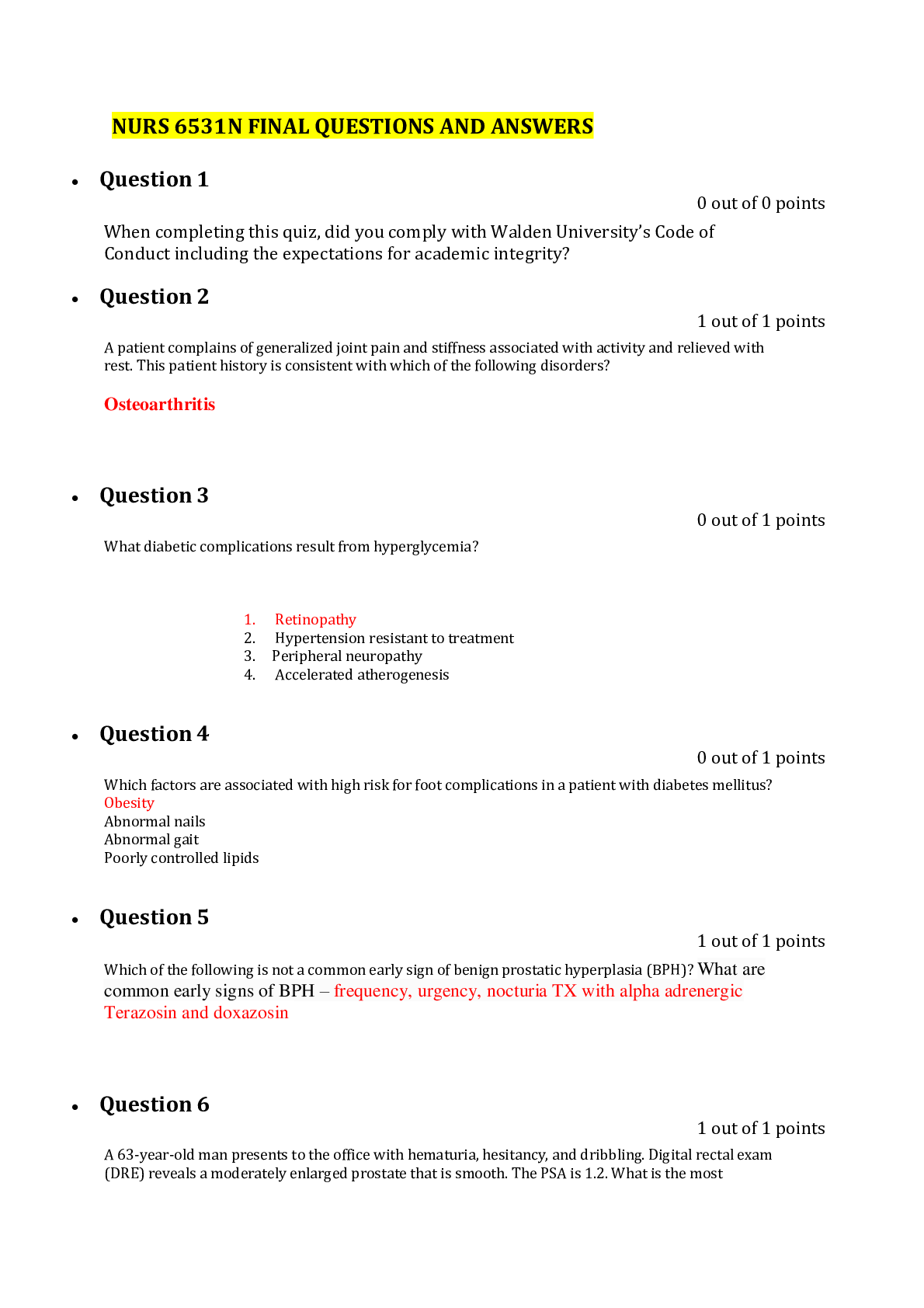
Reviews( 0 )
Document information
Connected school, study & course
About the document
Uploaded On
Jul 08, 2020
Number of pages
25
Written in
Additional information
This document has been written for:
Uploaded
Jul 08, 2020
Downloads
0
Views
47

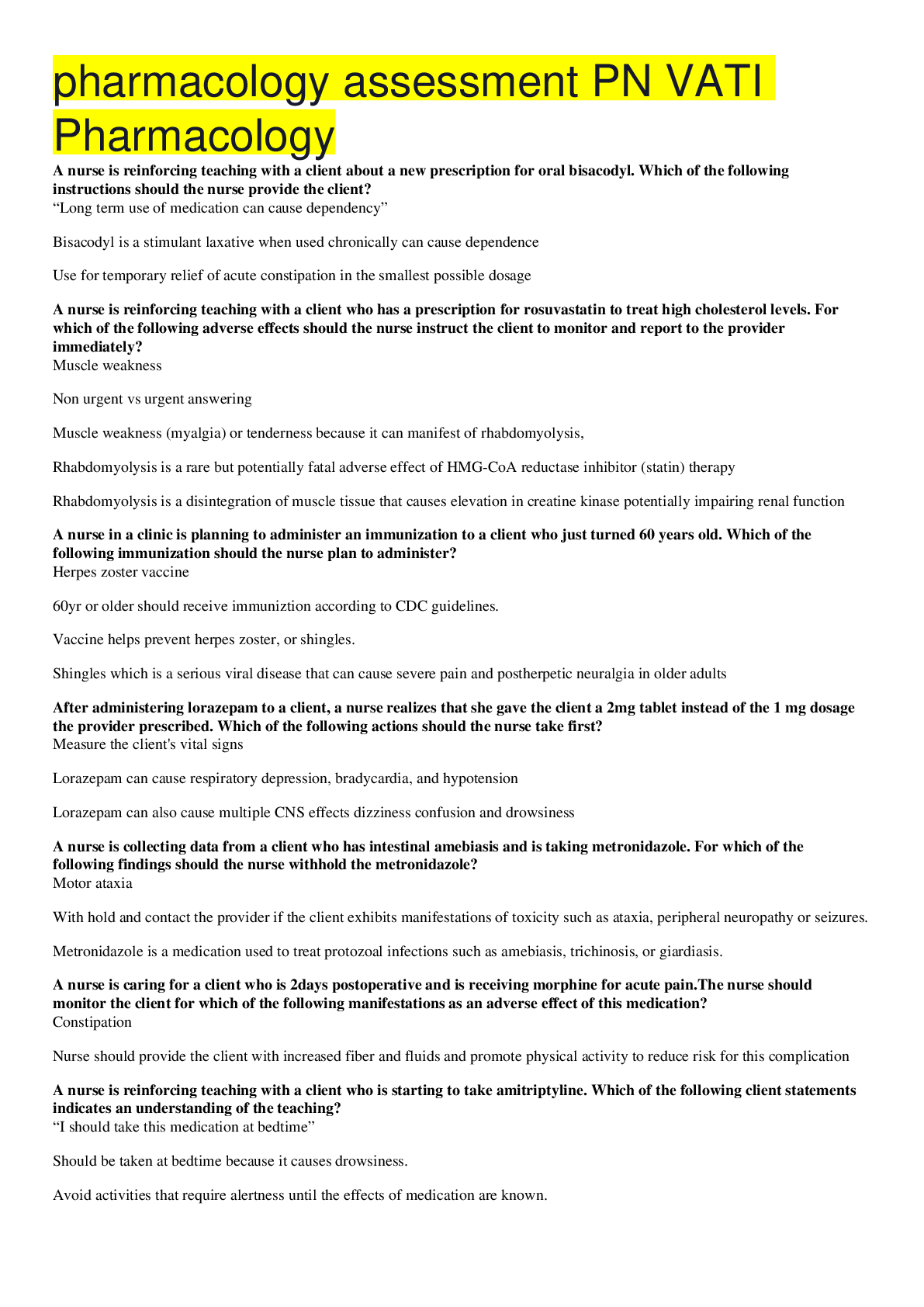
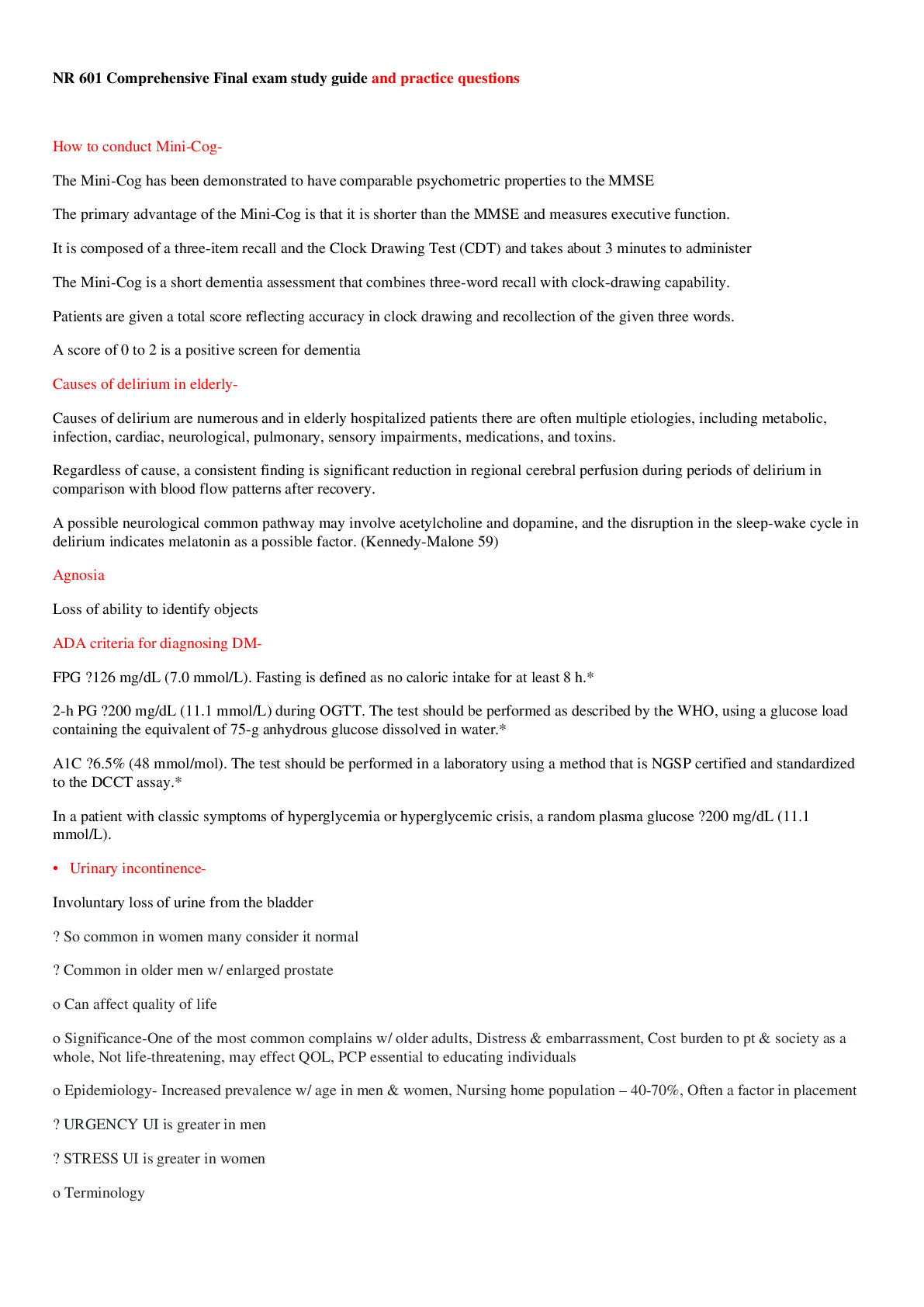
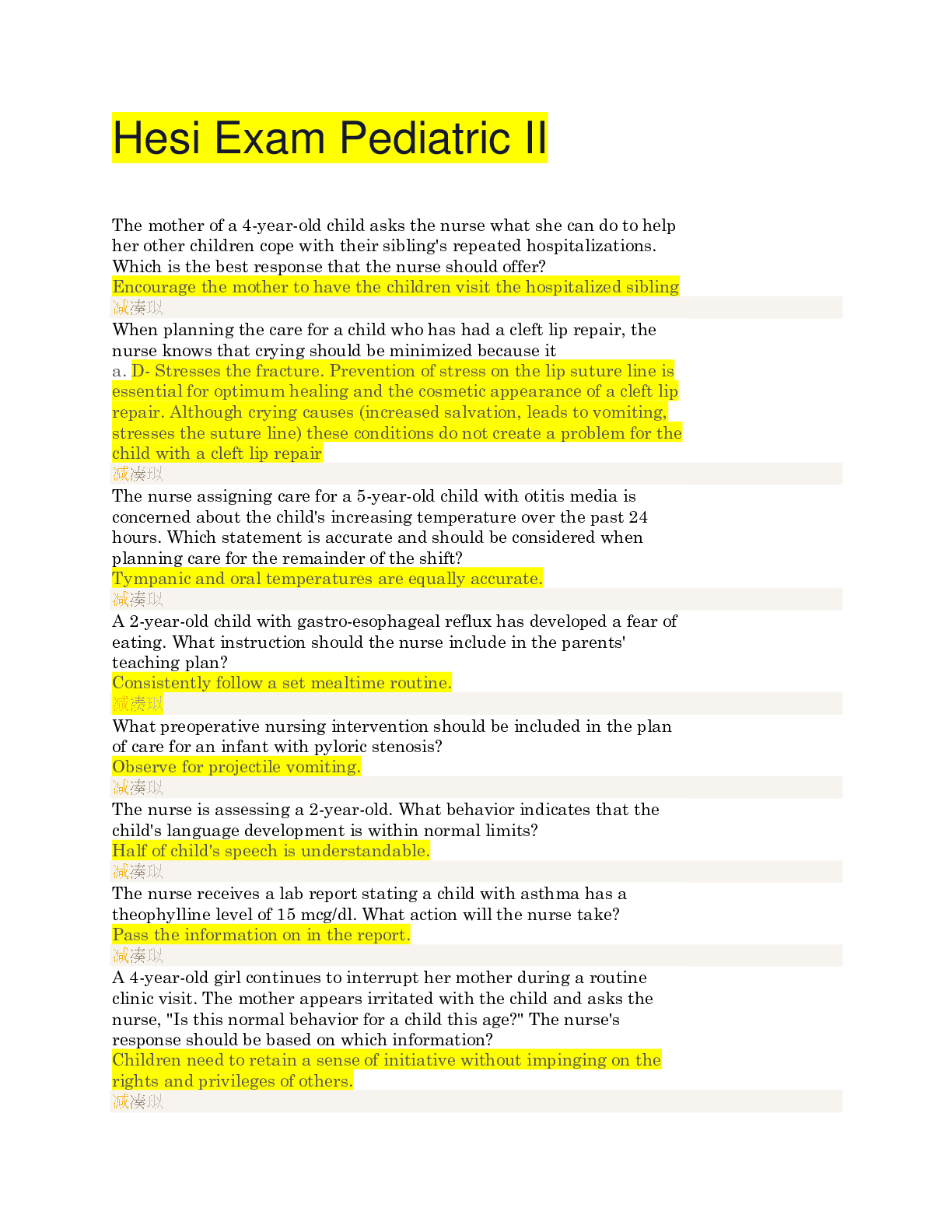


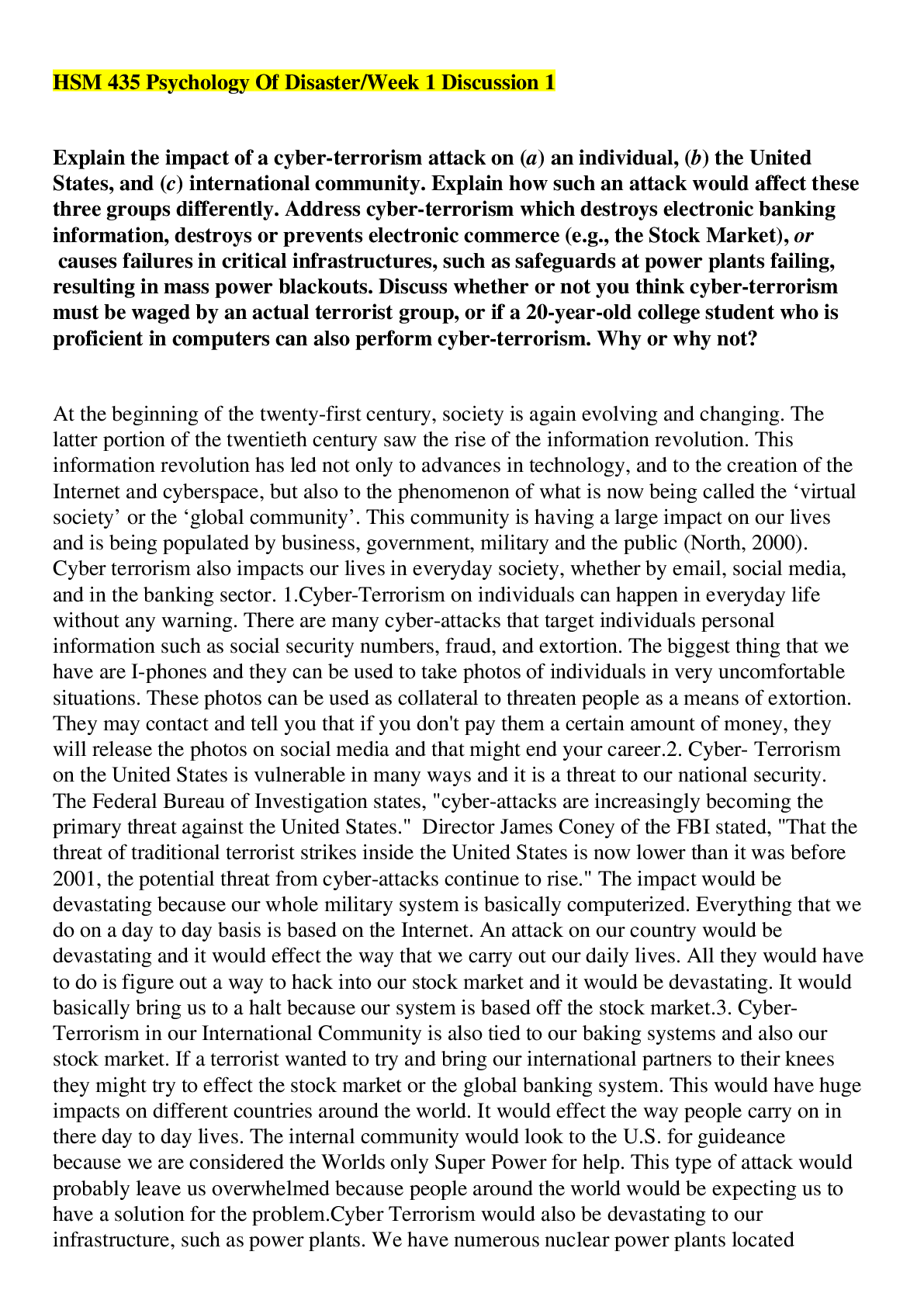

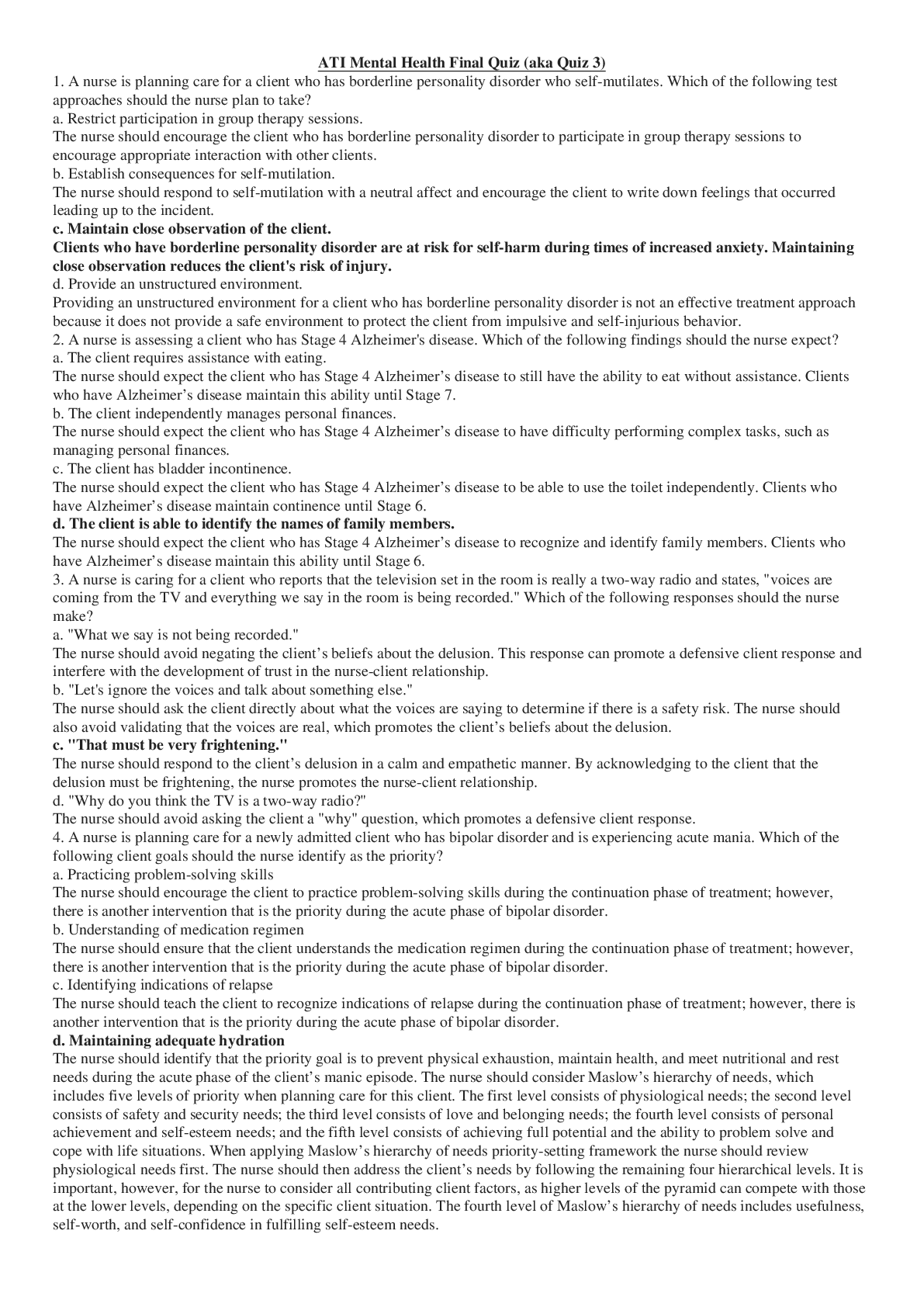

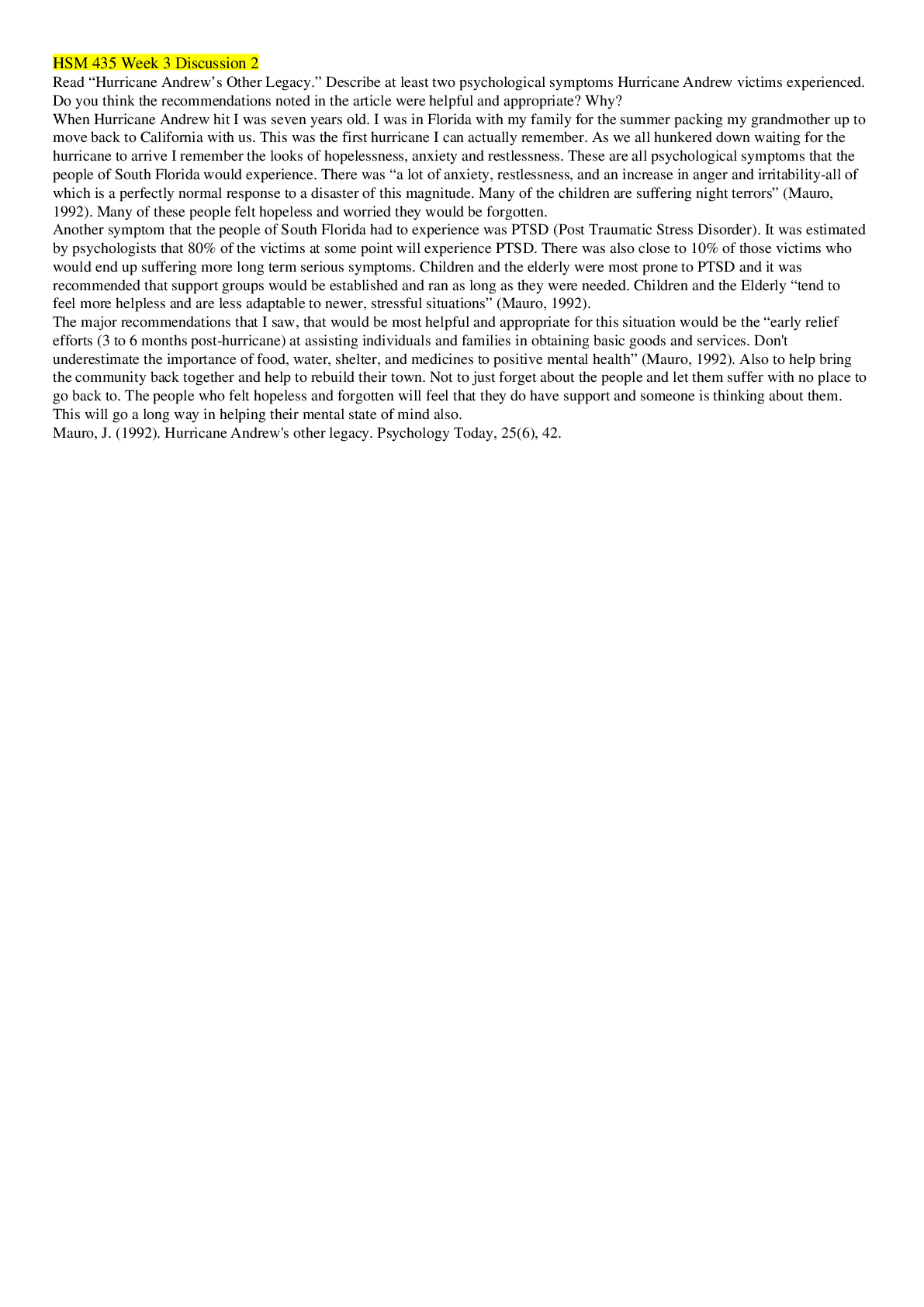
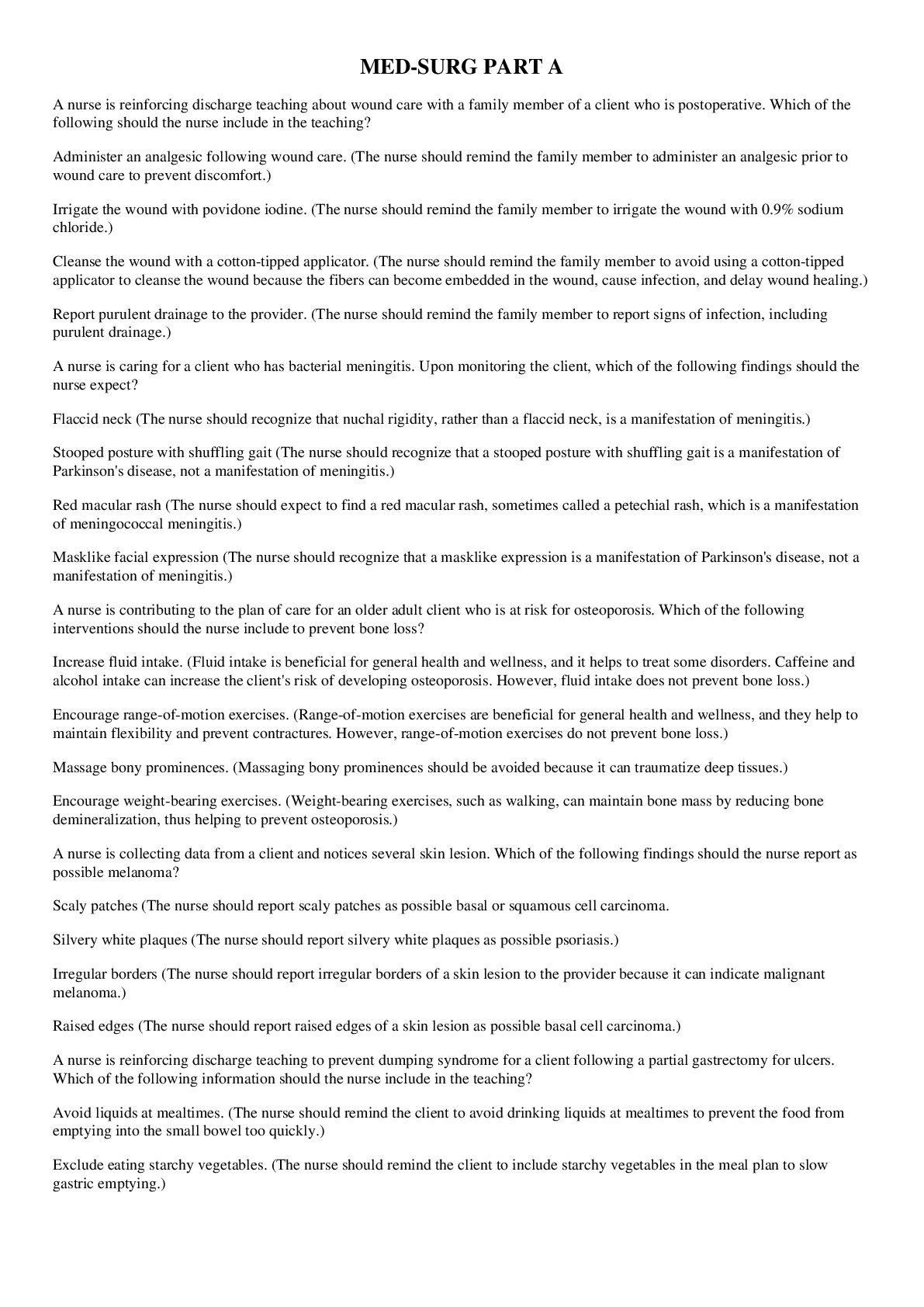


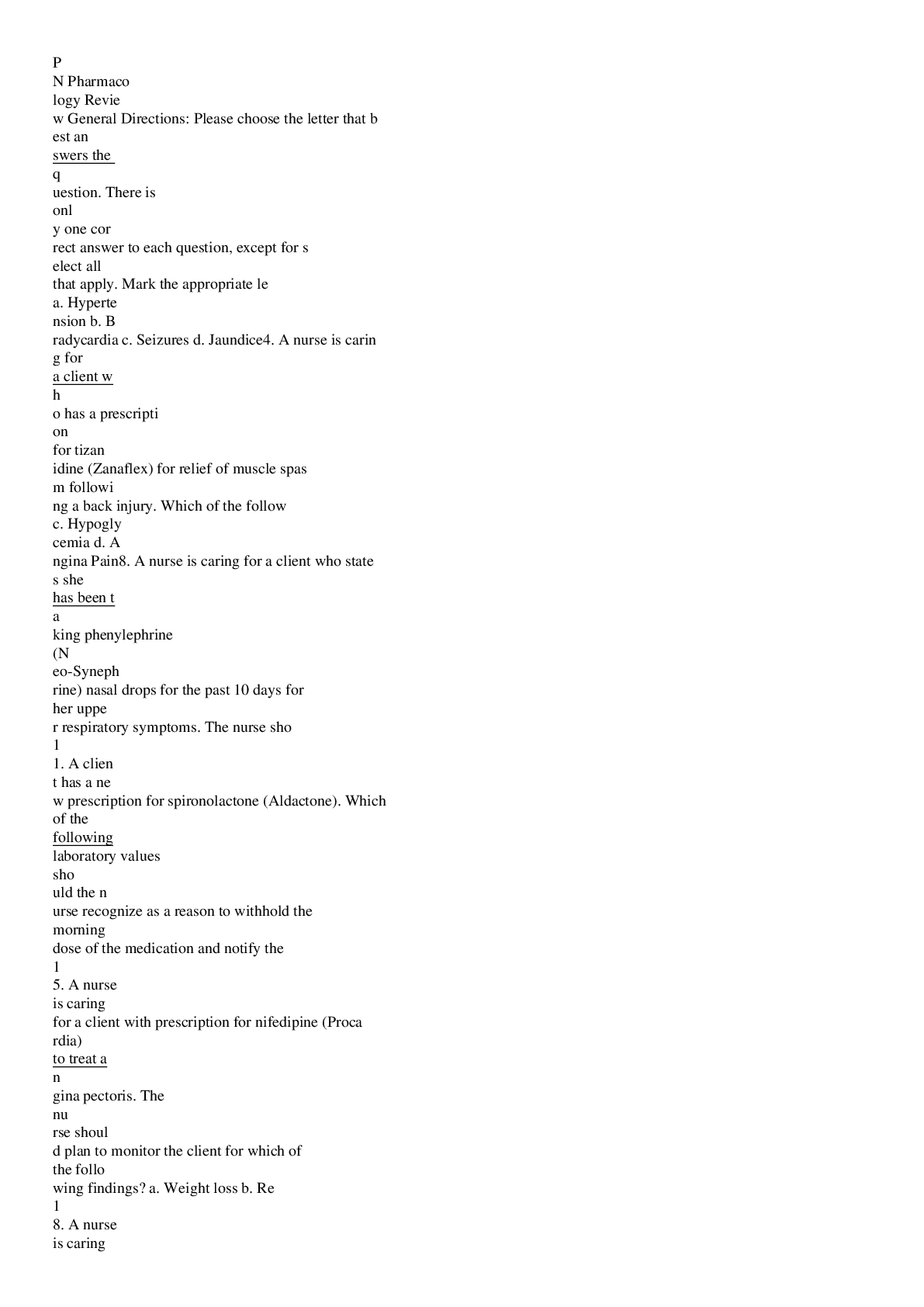
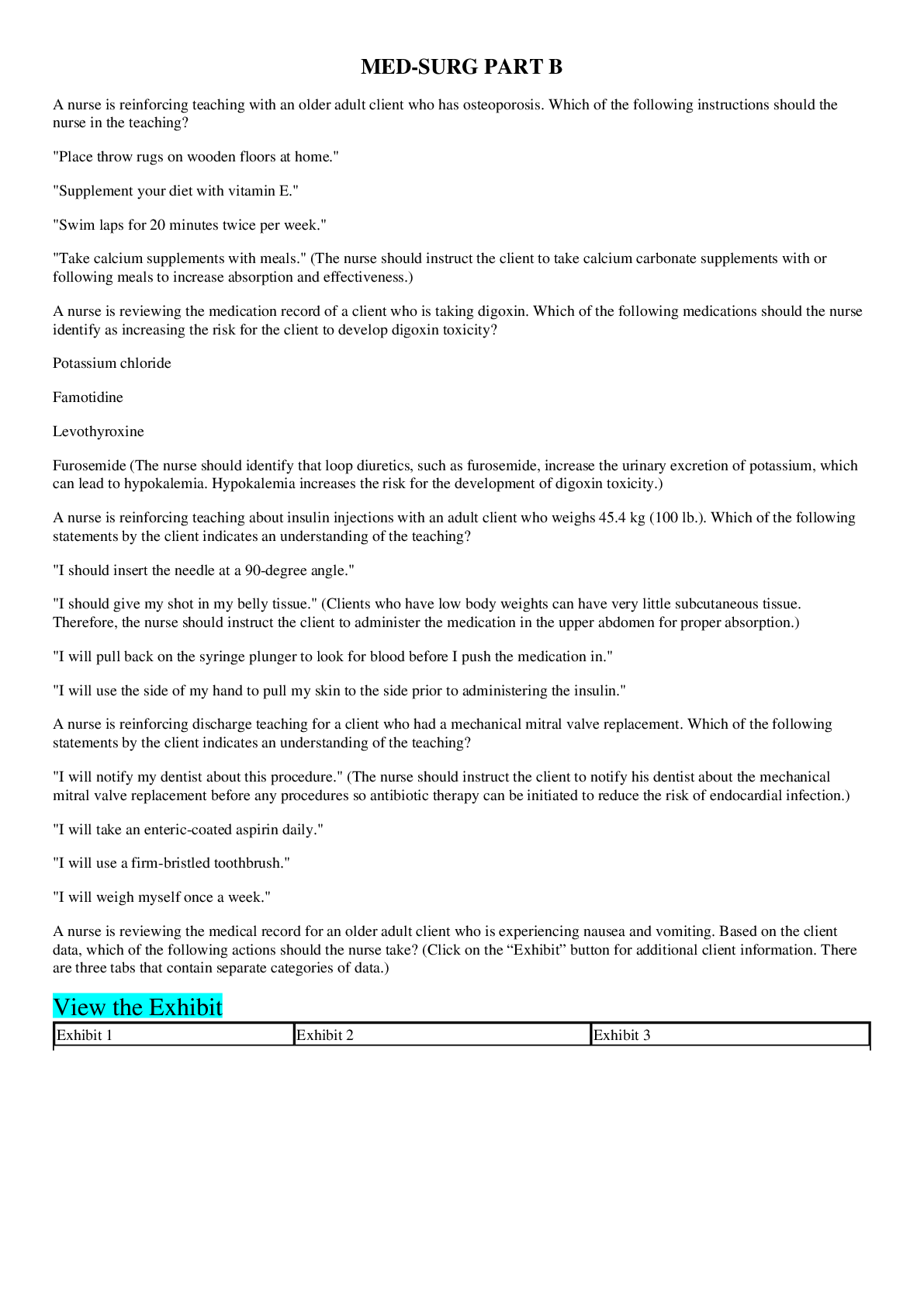
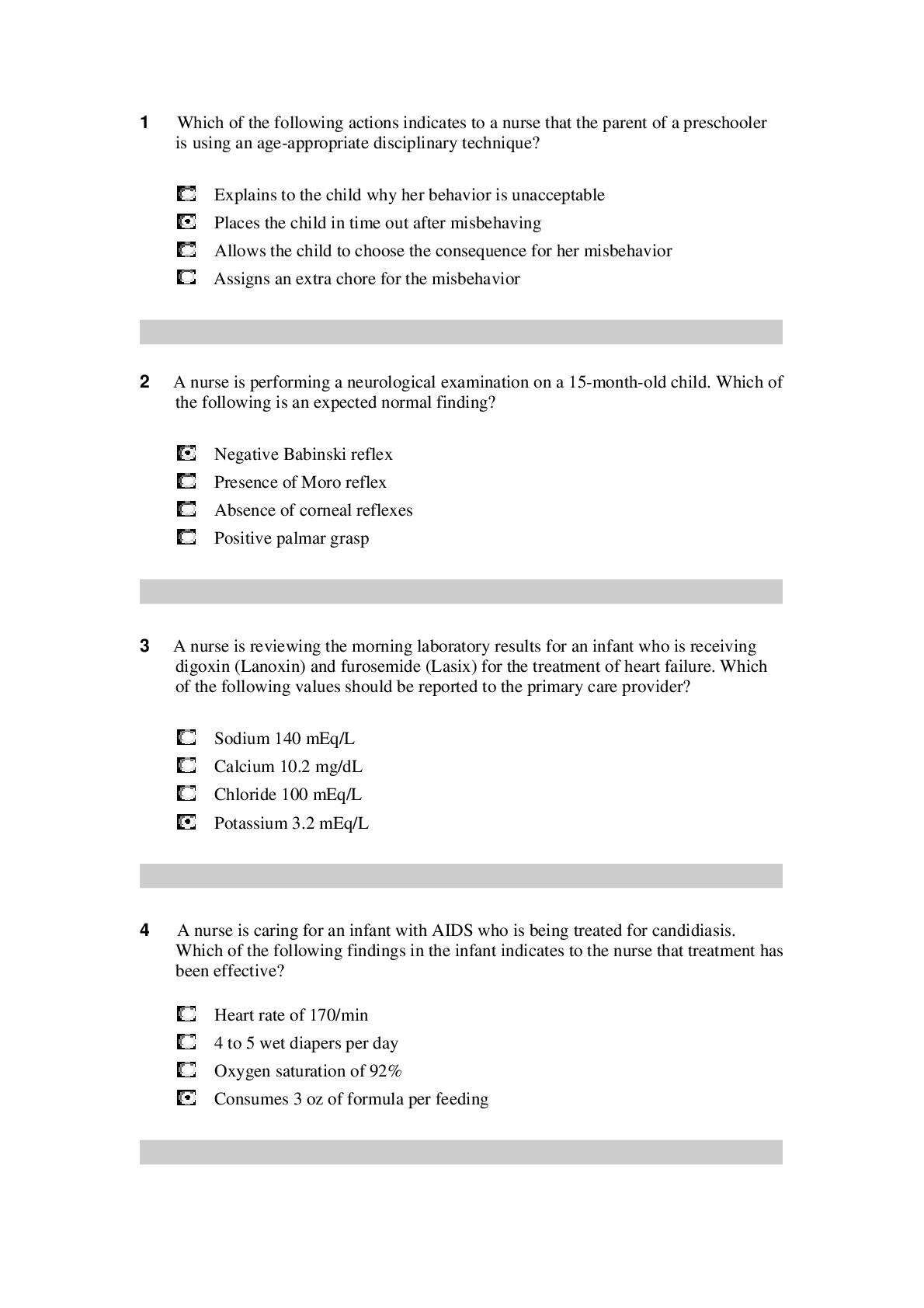

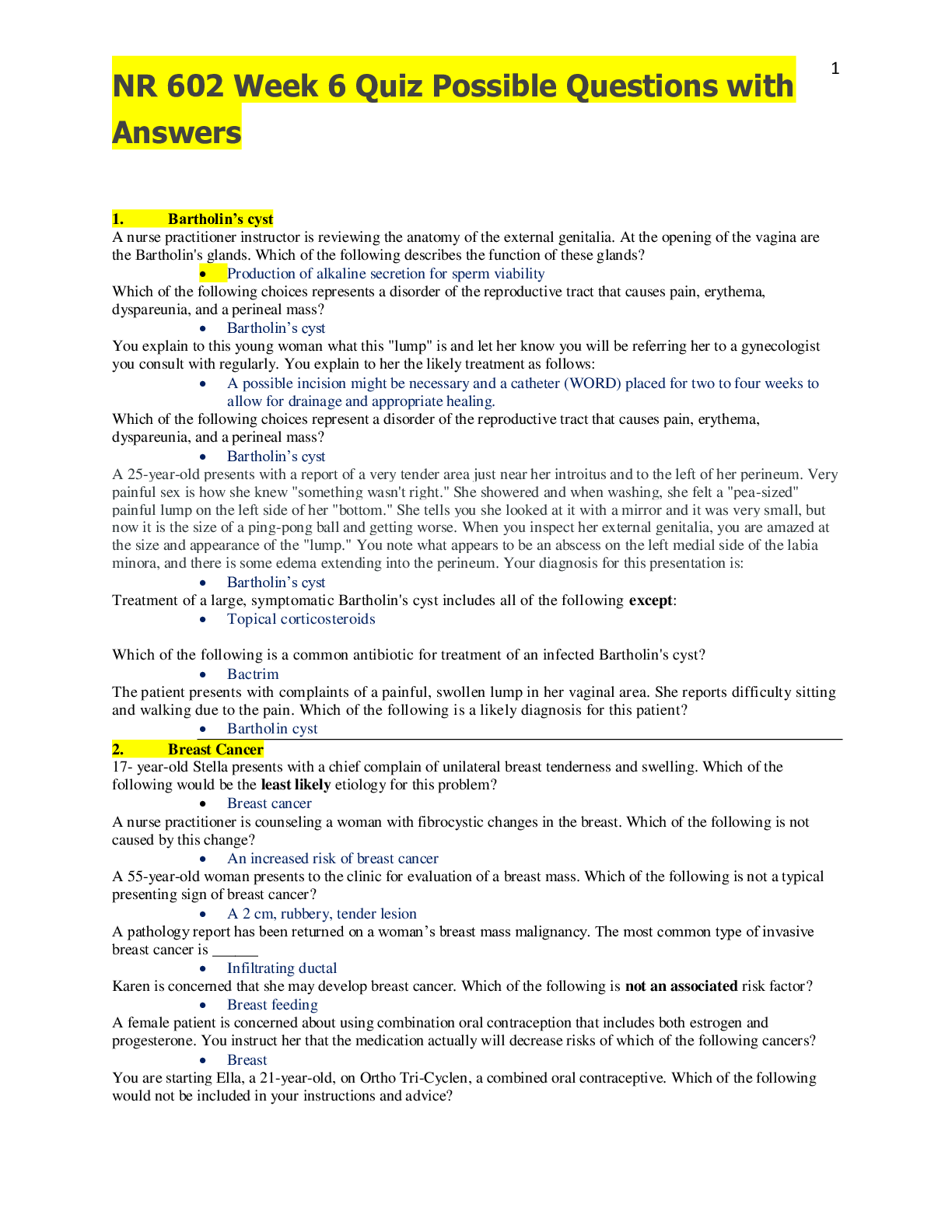
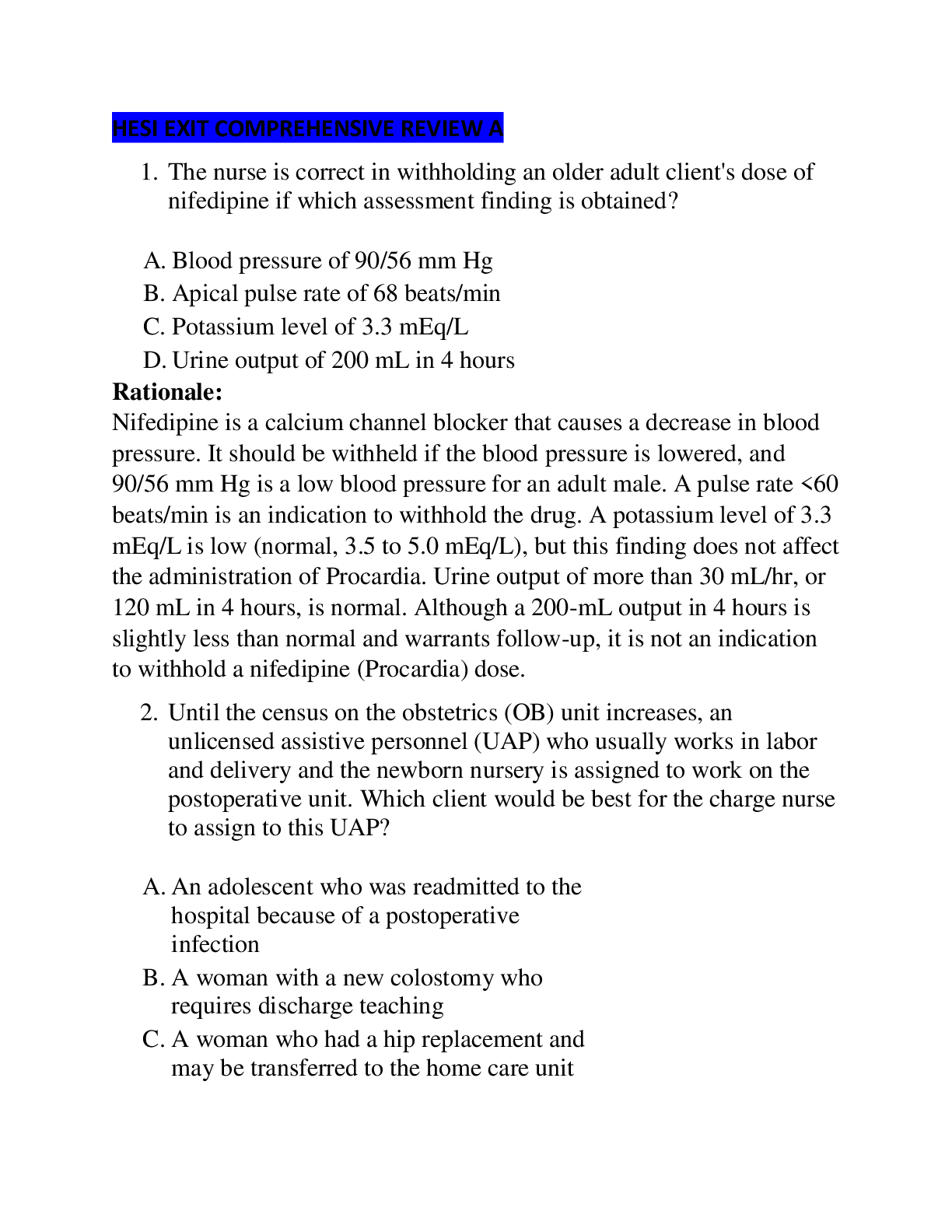
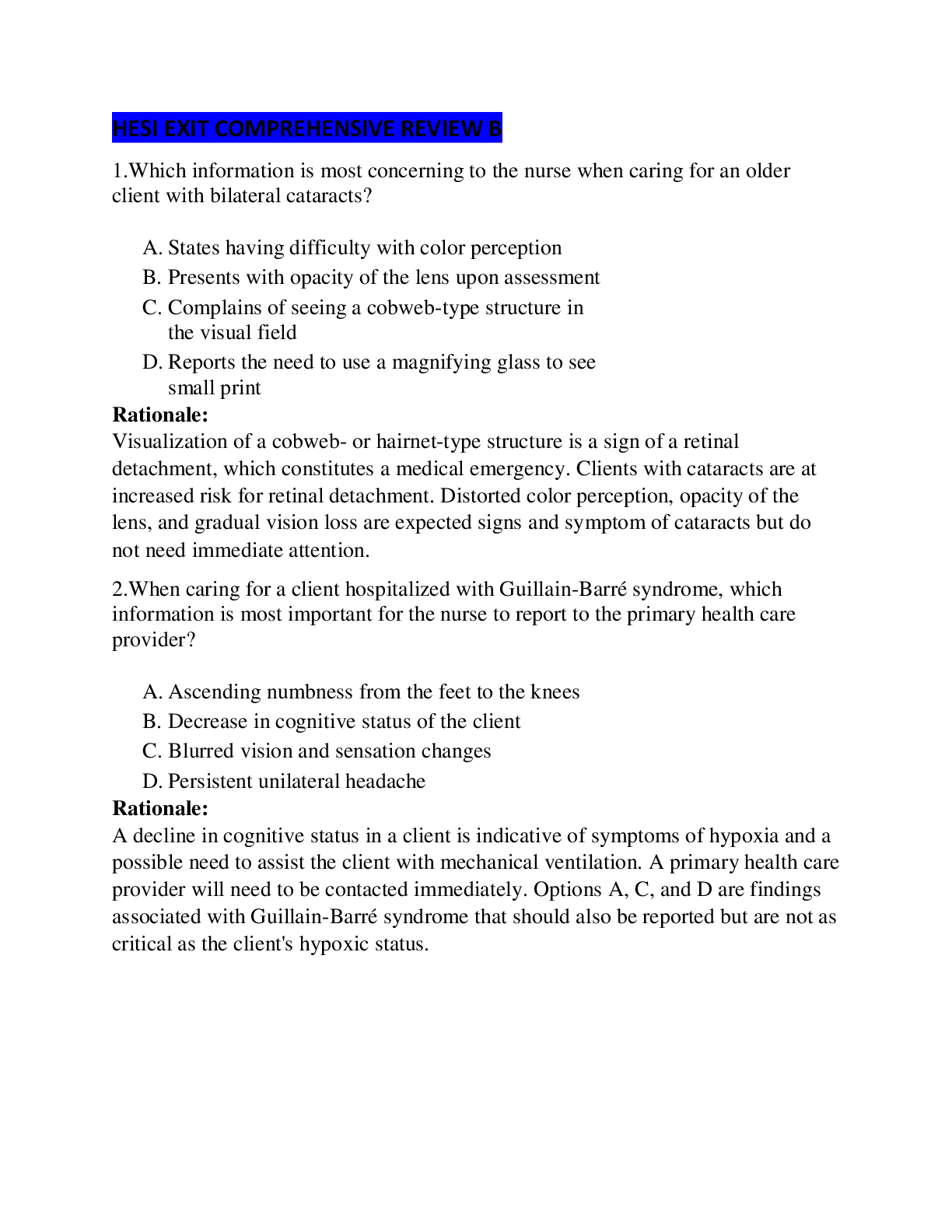
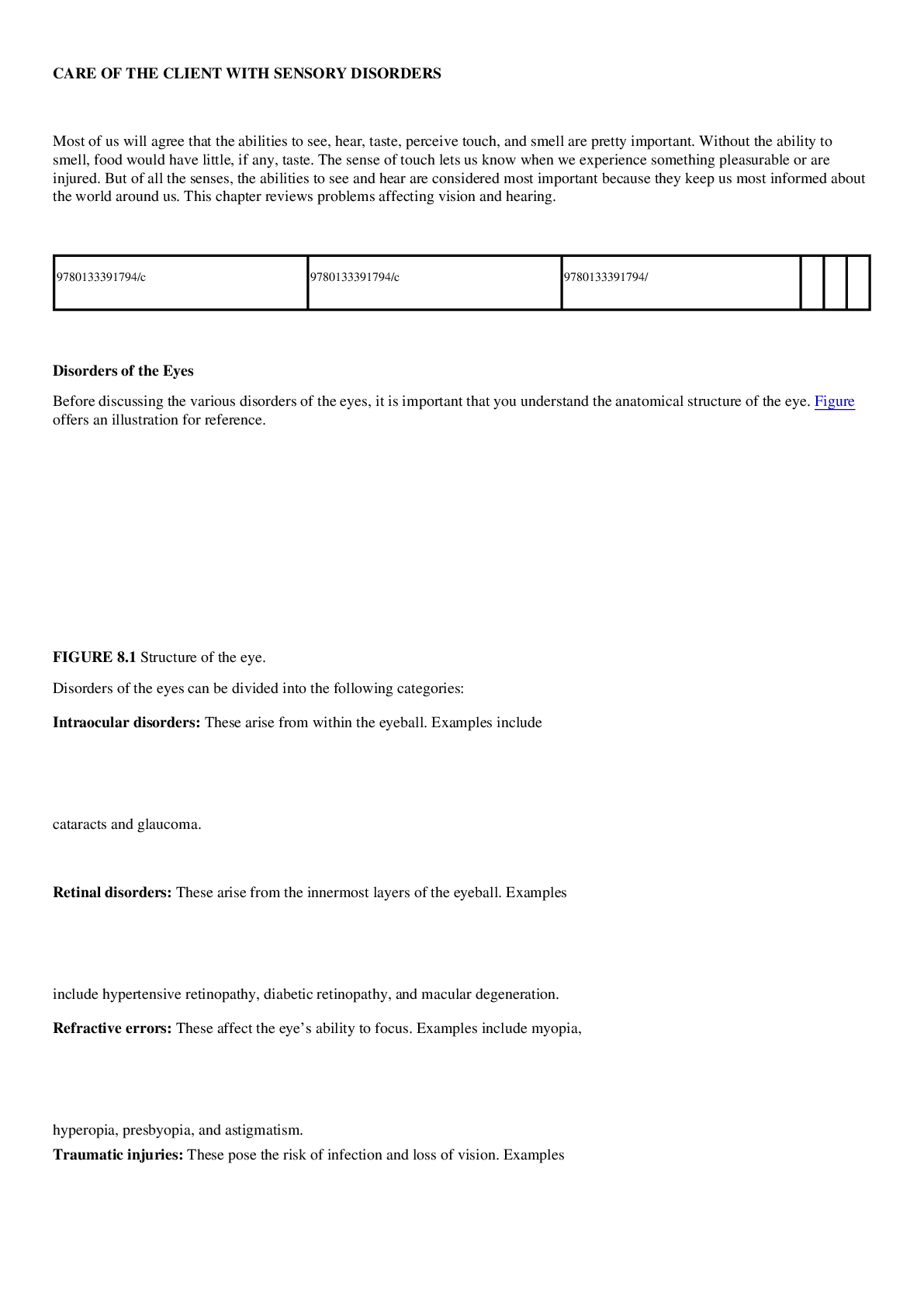





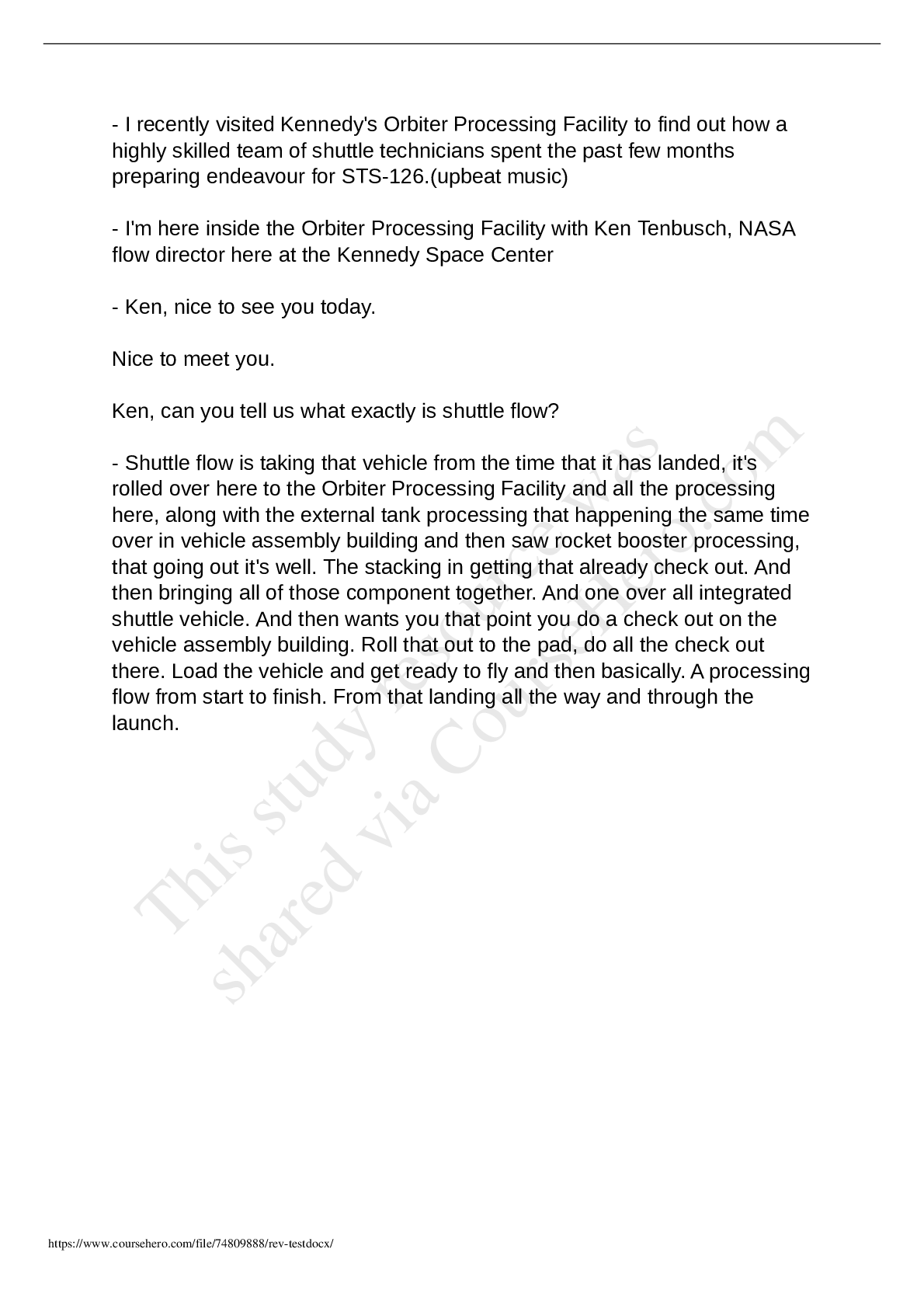

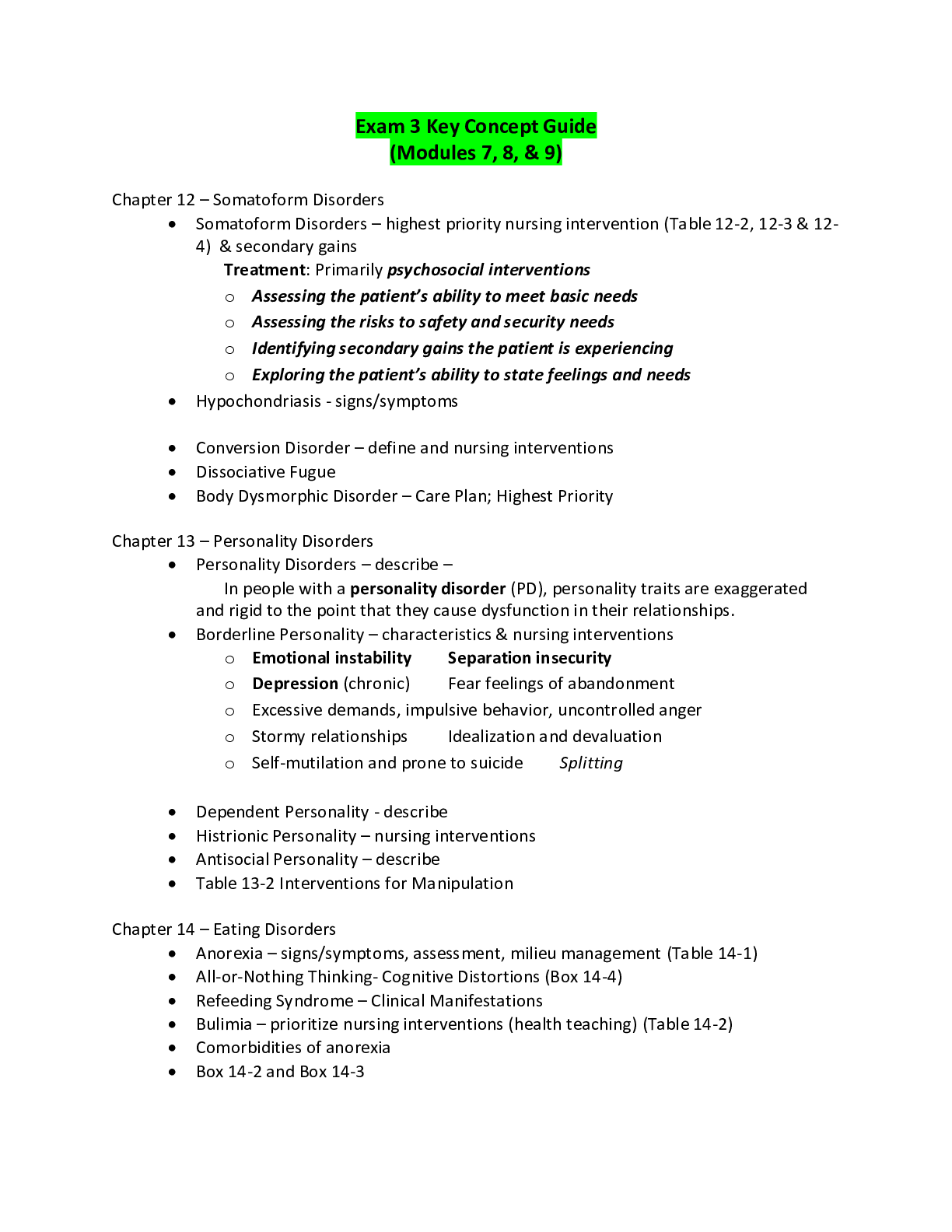
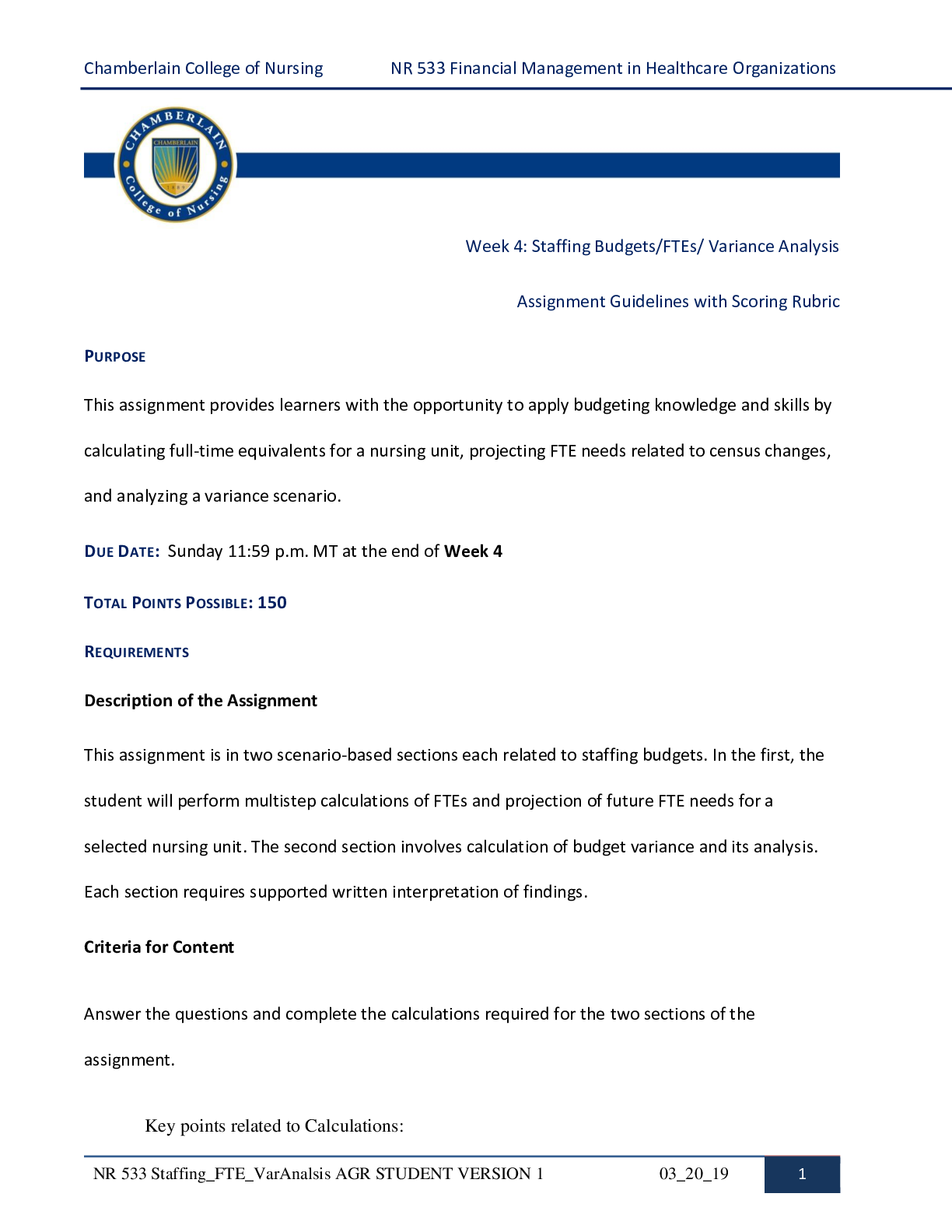
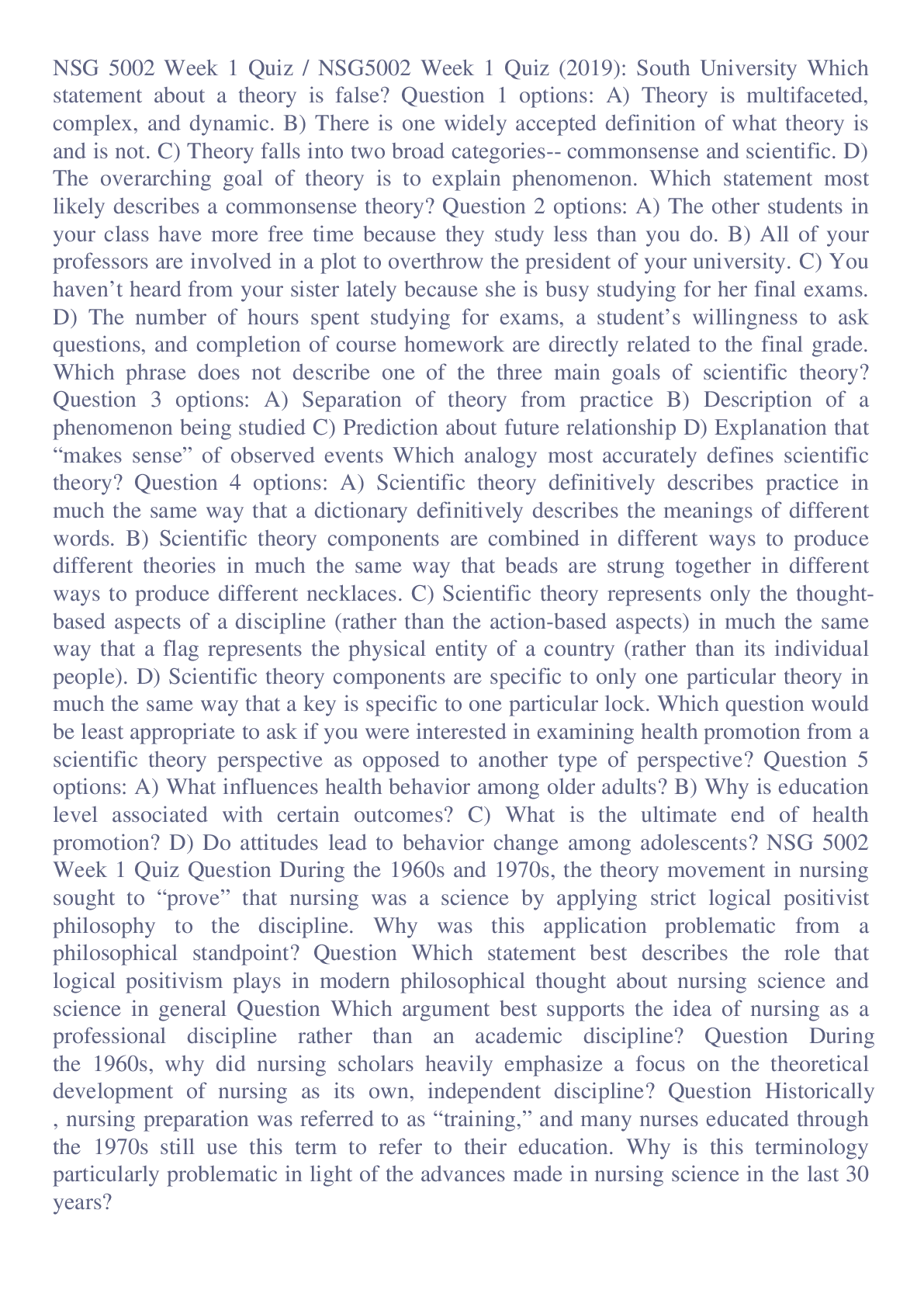

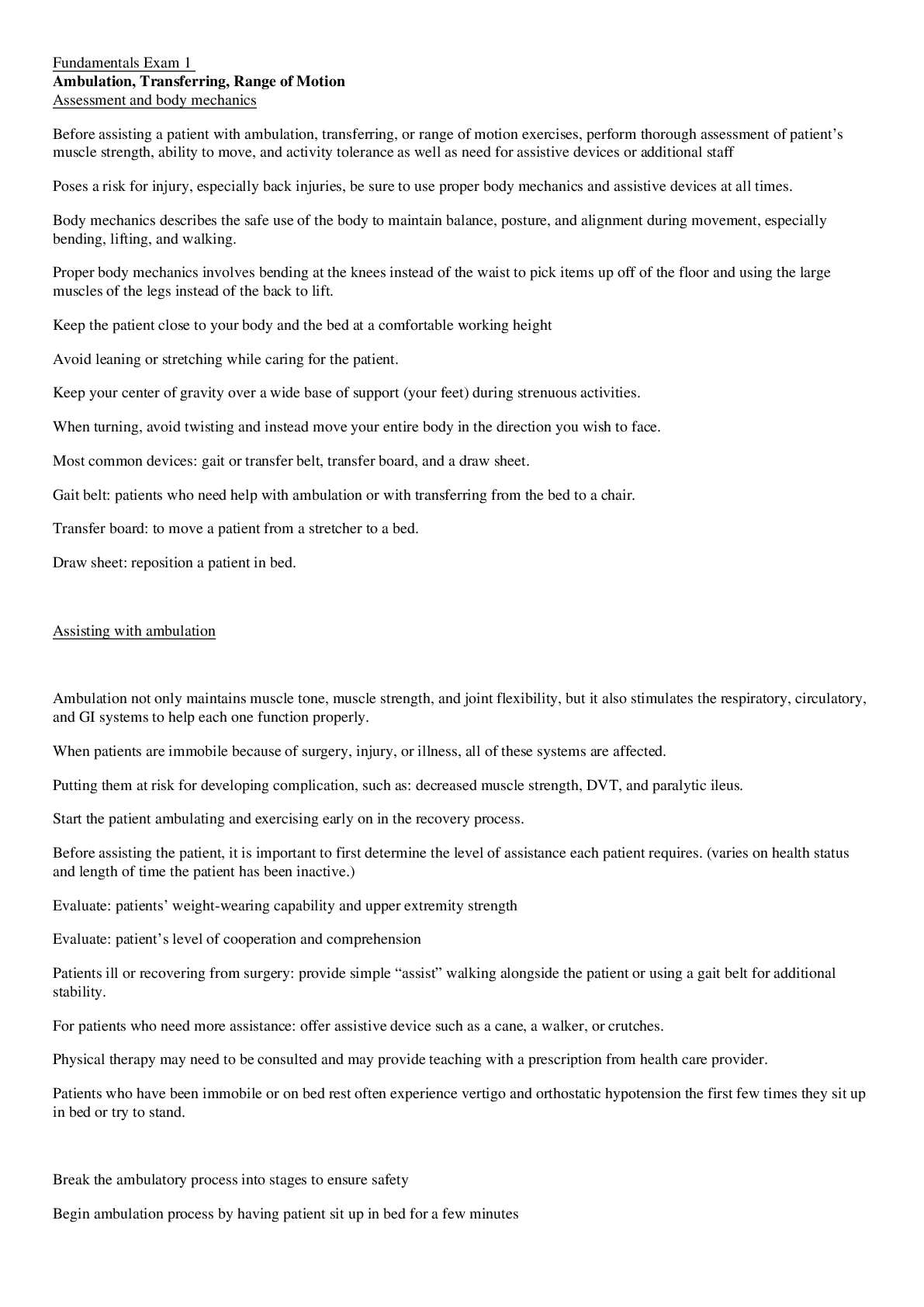

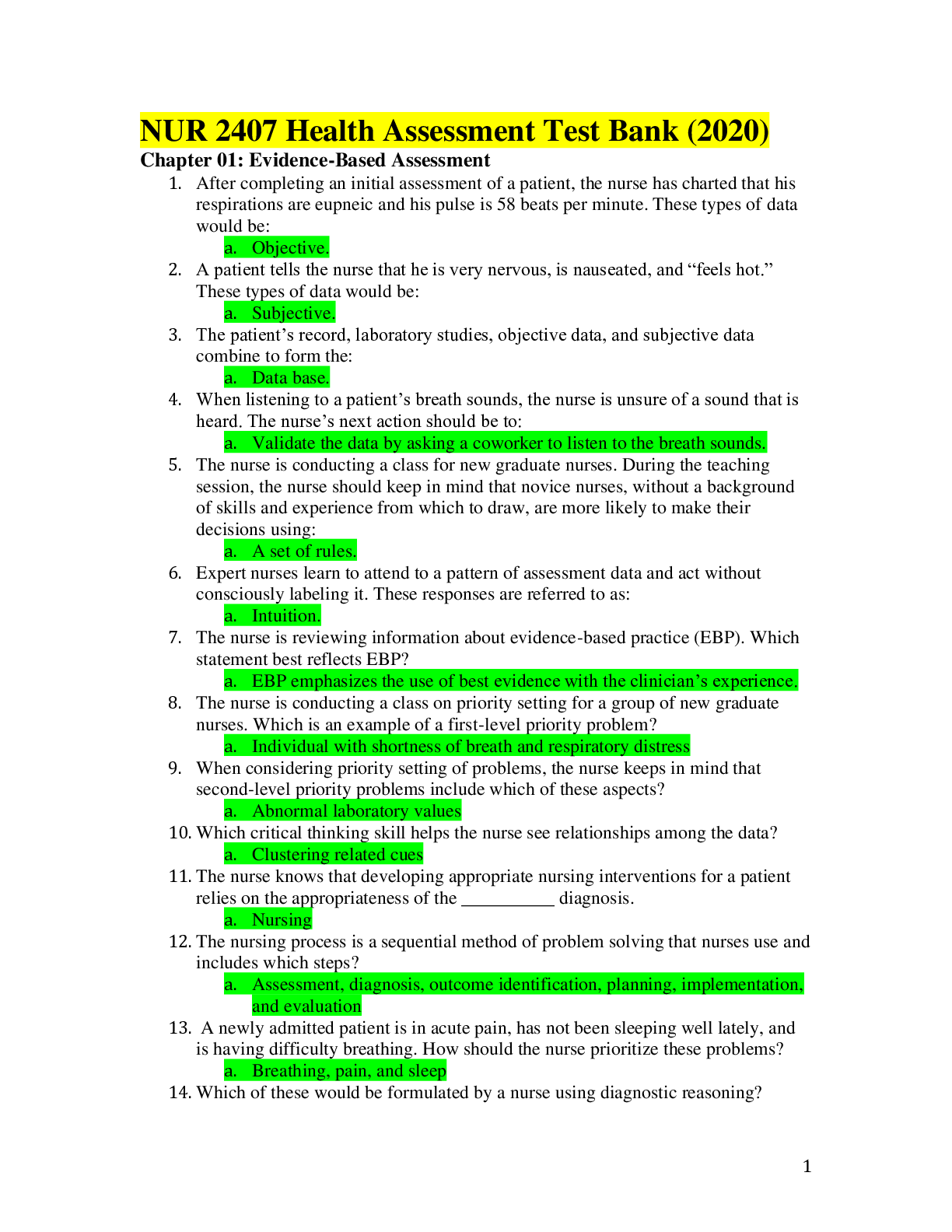
.png)

